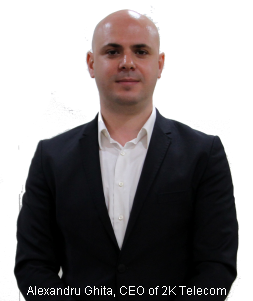TD-LTE Creates a New-Look 2K Telecom
 2K Telecom is a leading telecom services provider in Romania. The company offers WiMAX connectivity in partnership with a number of companies. 2K Telecom recently cooperated with ZTE on a TD-LTE project financed by the China Development Bank. At Mobile World Congress 2015, 2K Telecom and CDB signed a facility agreement. ZTE Technologies interviewed Alexandru Ghita, CEO of 2K Telecom, who talked about 2K Telecom’s LTE rollout, development plans, telecom trends, and partnership with ZTE.
2K Telecom is a leading telecom services provider in Romania. The company offers WiMAX connectivity in partnership with a number of companies. 2K Telecom recently cooperated with ZTE on a TD-LTE project financed by the China Development Bank. At Mobile World Congress 2015, 2K Telecom and CDB signed a facility agreement. ZTE Technologies interviewed Alexandru Ghita, CEO of 2K Telecom, who talked about 2K Telecom’s LTE rollout, development plans, telecom trends, and partnership with ZTE.
A: The Romanian telecom market is very competitive. In Romania, large multinationals have owned all types of mobile technologies, from 2G to present. We are a local fast-growing company that provides instant time-to-market 4G mobile services at a good price. We have individual, corporate and government customers. We cover well all business segments and requirements in the Romanian market and are an important player in this landscape.
A: The Romanian telecom market is recovering after recent economic crises, and consumers are still a little cautious because of the sluggish economy. Other challenges, especially for mid-sized operators, are volatility of financial markets and funding conditions.
A: 4G mobile is a major growth opportunity. The market itself is putting pressure on the mobile ecosystem to deliver new services such as M2M, mobile cloud, mobile TV, and NFC. We can control our costs better than our rivals because we don’t have the entire suite of technologies dragging us down. Our deployments are mostly greenfield, using technologies that are compact and energy-efficient. Our core network is flat, cheap to maintain, and easy to operate. We signed local roaming and MVNO agreements with operators in order to provide nationwide coverage and mobility for our customers. We benefit from our equipment, based on the latest cutting-edge technology and also used by China Mobile, and we can rapidly deliver a wide array of services.
A: WiMAX and TD-LTE share most of the RAN and transmission network, so the transition to TD-LTE was relatively smooth but not totally painless. For instance, in some areas, we decided to deploy TD-LTE as a second overlay network where WiMAX was available in order to guarantee a smooth transition for subscribers. One of the biggest challenges was that earlier WiMAX base stations could only be partly upgraded to TD-LTE, so we need extra support from the vendor. Another problem was that current WiMAX devices do not support TD-LTE and need to be replaced in the future. Reasonably priced multimode devices will make the transition from WiMAX to TD-LTE more attractive.
A: At the moment, we have built the sites and civil engineering work is underway. We are still waiting for some equipment to arrive and have begun testing some of the sites. The technology is working very well, and we have witnessed some very high speeds. In the near future, we will also try to implement carrier aggregation, and we are also looking forward to implementing VoLTE as well.
A: Actually, our cooperation started many years ago, I think five or six years ago. At the time, we knew something about ZTE, but we also tested other vendors. After testing three or four vendors, we found that ZTE had very good technologies and very good relationships with logistics companies and our partners. ZTE proved to be one of the best vendors on the market.
Q: How will future cooperation with ZTE progress?
A: We expect ZTE to maintain the high standard of its equipment, which we know and have experience with. In the future, infrastructure will be important, but we also want ZTE to help us with our professional services, connecting the networks, and also devising and implementing new business models.
A: At the moment, we are trying to position our services in the market, which is very competitive. There are three big operators; actually, we are the fourth operator with a 4G license. So at the moment, our strategy is to find a good niche where we can sell our services and not go head-to-head with the big operators already ruling the market.
A: It’s obvious that this convergence will happen sooner or later. For example, now in our network, some of our sites are already capable of around 200 Mbps and need very good backhaul, which is possible only with fixed technologies. Also, on the consumer side, we are seeing all kinds of fixed services packaged with mobile services, and it’s clear that the market is going in that direction.